SPECIAL CONTENTS
Story of Machiya(traditional townhouse)
Kyoto ICHINODEN Main Store is an old machiya style building. From the exterior to the interior, each and every corner is finely decorated. It is a comfortable space that is both functional and beautiful. Let us introduce to you one by one.

Roof arch
At first glance it looks like a normal triangular roof, but if you look from the side you will see that it is in fact slightly arched . While looking extremely elegant, it also has a function of gathering rainwater.

Mushiko window (window with an ultra-fine lattice)
This unique lattice window is commonly placed on the second floor. It is wrapped by straw and painted with plaster from above. Because the shape of the window is similar to an insect cage, it is called “Mushikago”, meaning insect cage. The mushikago window was made for fire prevention as well as to prevent people inside the house from seeing pedestrians on the street.

Ichimonjigawara (Straight eaves tile)
The eaves of machiya are often in a straight line, and this feature is known as “ichimonjigawara (straight eaves tile). A straight eaves tile has to line up its bottom line with no gap in between, therefore each and every piece of the tile must be placed neatly and uniformly. This demonstrates the extraordinary level of skill of the craftsmen who created this.

Willow
Yanagi no Banba-dori is where Kyoto ICHINODEN Main Store is located. The street is named “Yanagi no Banba” (meaning willow horse riding ground) because many willow trees were planted there by Hideyoshi Toyotomi, and the military horse training was carried out there during the Edo period. The willow tree greets our guests with a graceful gesture while reminding us the historical scene at the time.

Lattice window
Lattice window was invented during the Sengoku period for defensive purposes. The advantage of the lattice windows is that while it is difficult to see the interior of the house from the outside, outside can be clearly seen from the inside. And at the same time, allowing the light and wind to come through. This feature can be seen in most machiya.

Udatsu (Short pillar)
The short pillars at the two ends of the roof were originally built as firewalls to prevent fire from the neighbour’s side. Later, it gradually evolved into part of the decoration of the house, as well as a tool to indicate the wealth of that family. The word “Udatsu” is used in an idiom “Udatsu ga agaru”, meaning to get ahead in life.


